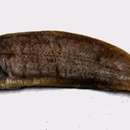Comprehensive Description
provided by Smithsonian Contributions to Zoology
Cynoglossus joyneri Günther
Cynoglossus joyneri Günther, 1878:486 [type-locality: Tokei, Japan]; 1880:70 pl. 30; fig. A [Tokyo].—Otaki, 1897:25.—Wu, 1932:154; 1933:61 [Chefoo].—Wu and Wang. 1933:304 [China].—Chabanaud, 1951d:269.—Tchang, 1955:301, fig. 186.—Ochiai, 1959:208; 1963:88, pl. 18.—Chu, 1963:542, fig. 408.—Shen, 1967:211 [Kowloon].
Areliscus joyneri.—Jordan and Snyder, 1900:380 [Tokyo].—Jordan and Starks, 1906a:241 [Tokyo].—Smith and Pope, 1906:498 [Kochi].—Snyder. 1912:441 [Kagoshima].—Jordan, Tanaka and Snyder, 1913:336 [listed].—Jordan and Hubbs, 1925:302.—Kuroda, 1931:122.—Kamohara, 1938:62 [Tosa].—Kuronuma, 1939:83.—Yanai, 1950:22.—Kuroda, 1951:390.—Kamohara, 1952:85.—Honma, 1952:225.—Chen and Weng, 1965:100, fig. 70 [Tung Kong].
Cynoglossus (Areliscus) lighti Norman, 1925:270 [type-locality: Amoy and Wenchow].
Cynoglossus lighti.—Chu, 1931:95.—Wu, 1932:155 [Tang-Tchou and Amoy].—Chabanaud, 1951a:270.—Wang, 1933:63, fig. 30.
Trulla lighti.—Fowler, 1954b:216.—Chen, 1951:123.
Areliscus tenuis Oshima, 1927:201 [type-locality: Tainan].
Cynoglossus tshusanensis Chabanaud, 1951d:270 [type-locality: Tshusan Archipelago, China].
DESCRIPTION.—Based on 10 specimens, 193.0–199.0 mm SL.
Depth of body 20.28–43.64 (M = 25.88), length of head 18.86–40.00 (M = 23.75) percent of standard length. Diameter of eye 7.14–10.14 (M = 8.80), interorbital space 4.76–7.95 (M = 4.46) percent of length of head. Two nostrils on ocular side, anterior nostril tubular in front of lower eye, posterior nostril simple in anterior half of interorbital space. Snout obtusely pointed, 32.73–42.03 (M = 36.54) percent of length of head, rostral hook rather short and extending to front of anterior nostril. Maxillary extending well beyond posterior border of fixed eye; angle of mouth extending to almost below vertical from posterior half of fixed eye or even beyond, being more or less midway between tip of snout and branchial opening; tip of snout to angle of mouth 47.62–60.32 (M = 51.34), angle of mouth to branchial opening 47.06–63.49 (M = 52.26) percent of length of head.
Scales: Ctenoid on ocular side, including those of lateral lines; on the blind side scales are cycloid on head, weakly ctenoid on body.
Lateral-Line System: Usually three lateral lines on eyed side, the dorsolateral line undulates and runs backward along dorsal contour of body, usually entering dorsal fin along 7th ray counted from the rear, midlateral line with 66–72 (M = 70) scales, 11–12 (M = 12) scales between middle and upper lateral line, ventrolateral line usually present, entering anal fin along 5th to 7th ray counted from the rear. No lateral line on blind side.
Interlinear scale rows 11 12
Frequencies 1 8
Fins: Dorsal with 105–112 (M = 109) rays, anal with 81–85 (M = 83) rays, caudal 10 in 7 specimens (radiographs).
Vertebrae: 50–53 (M = 51) comprising 9 abdominal and 41–44 caudal elements in 7 specimens (radiograph).
Coloration: Upper side brownish, blind side yellowish white in preserved specimens.
Size: Largest specimen examined, 231.5 mm SL, is from Japan (BMNH 1878.4.5.94).
DISTRIBUTION.—From South China Sea through Taiwan, Tung-hai, Yellow Sea, Po-hai to Korea and Japan.
DIAGNOSIS AND
- bibliographic citation
- Menon, A. G. K. 1977. "A systematic monograph of the tongue soles of the genus Cynoglossus Hamilton-Buchanan (Pisces, Cynoglossidae)." Smithsonian Contributions to Zoology. 1-129. https://doi.org/10.5479/si.00810282.238

